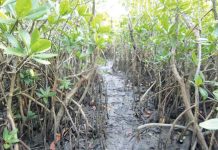
By RD Dianala and HP Villa
NOT all leaves which fall to the ground are litters. There is one particular kind of leaf – the talisay leaves – sustains fish life.
A recent study has shown that the leaves of the common talisay (also known as the Indian or tropical almond tree) improve the survival of the ayungin larvae, or silver therapon (Leiopotherapon plumbeus) a freshwater fish consumed by many Filipinos.
Southeast Asian Fisheries Development Center (SEAFDEC) scientist Dr. Frolan Aya conducted a study which proved that the talisay leaves, when added and allowed to decompose in fish culture tanks, resulted to 48 percent survival of ayungin larvae, whereas those without the leaf substrate only achieved a 27 percent survival rate.
Aya’s study co-authored by Vicar Stella Nillasca, Mary Jane Sayco and Luis Maria Garcia was published this year in the 66th volume of the journal Ichthyological Research. He also obtained a patent from the Intellectual Property Office of the Philippines on Oct. 17, 2019 for the hatchery technology of ayungin using talisay leaves.
Acccording to their research, “aqueous extract of tropical almond leaves are known to contain tannins that enhance water quality by reducing pH and TAN (Total Ammonia Nitrogen) levels.” Further, other studies have shown that talisay leaf extracts also possess antimicrobial and antifungal properties due to the presence of an array of beneficial organic compounds.

Talisay is a common ornamental tree in the Philippines often planted in coastal communities. Its broad leaves in shades of yellow, orange and red fall and die in summer. But during the rainy season, the leaves will turn a brilliant green once more.
Aya’s study showed that by simply littering hatchery tanks with talisay leaves, it allows small organisms such as zooplankton and insect larvae to colonize the leaf surfaces and these organisms soon became food for the ayungin larvae.
It might have also been possible, according to the study, that the accumulation of leaves at the tank bottom reduced water motion and allowed the larvae to conserve their energy instead of going against the flow of current.
The research suggested that the decomposing leaves caused the water to darken thus, “the darkening of the rearing lake water may also provide a good background or contrast for the larvae to efficiently capture its prey, thus contributing to better feeding success and consequently significantly improved larval survival in the present study.”
Previous studies have shown that the mere presence of leaf litter in culture tanks presents some advantages to improve fish survival. However, other studies using only extracts of the talisay leaf without the litter have shown significant improvements in the survival of fish and even tiger shrimp (Penaeus mondon).
SEAFDEC/Aquaculture Department said that placing dried talisay leaves in culture tanks appears to provide both the physical benefit of a leaf litter substrate as well as the leaching of desirable organic chemicals to the rearing water. While the method seems simple, more study is still needed, especially on new applications.
As a result of this study, SEAFDEC can now sweep away all the talisay leaves that litter its driveway to their hatcheries and laboratories to aid the aquaculture industry./PN



